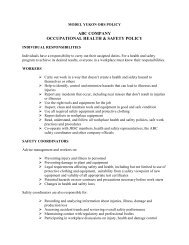protecting vulnerable workers in your workplace - OHS Insider
protecting vulnerable workers in your workplace - OHS Insider
protecting vulnerable workers in your workplace - OHS Insider
- No tags were found...
You also want an ePaper? Increase the reach of your titles
YUMPU automatically turns print PDFs into web optimized ePapers that Google loves.
4 PROTECTING VULNERABLE WORKERS IN YOUR WORKPLACEHow 'Newness' Impacts Workplace Safety, Cont'dIn addition, because recent immigrants are often underemployed<strong>in</strong> terms of hours worked, they may be will<strong>in</strong>g to takeon more dangerous tasks at work. As a result of all of thesefactors, recent immigrant <strong>workers</strong> have a higher risk of <strong>in</strong>jurythan non-immigrant <strong>workers</strong>. For example, one study foundthat male immigrants <strong>in</strong> their first five years <strong>in</strong> Canada reportedtwice the rate of work-related <strong>in</strong>juries requir<strong>in</strong>g medicalattention than Canadian-born male <strong>workers</strong>.ConclusionThe IWH brief<strong>in</strong>g demonstrates the importance of safetytra<strong>in</strong><strong>in</strong>g for young <strong>workers</strong> and new <strong>workers</strong> of all ages. Inaddition, the brief<strong>in</strong>g supports the need to take measures toaddress language barriers <strong>in</strong> the <strong>workplace</strong>, especially if youhave a large number of <strong>workers</strong> who are recent immigrantsand don’t speak English or French as their native tongue.INSIDER SOURCE“‘Newness’ and the risk of occupational <strong>in</strong>jury,” The Institutefor Work & Health, May 20092011 © Bongarde • www.<strong>OHS</strong><strong>Insider</strong>.com
PROTECTING VULNERABLE WORKERS IN YOUR WORKPLACE5One k<strong>in</strong>d of worker who requires special protection is theyoung worker. Why? Young <strong>workers</strong> aren’t used to the<strong>workplace</strong> and its safety rules. They’re also likely to be perform<strong>in</strong>gtasks, us<strong>in</strong>g tools and operat<strong>in</strong>g equipment withwhich they’re unfamiliar. And they may be reluctant to askquestions.Here’s a look at the special safety protections the law givesto young <strong>workers</strong> and how to comply with those requirements.There’s also a chart on page 8 outl<strong>in</strong><strong>in</strong>g the protectionsfor young <strong>workers</strong> <strong>in</strong> each jurisdiction.YOUNG WORKER ORIENTATION: There’s a Young WorkerSafety Orientation Checklist on page 9. Go to the <strong>Insider</strong>’sonl<strong>in</strong>e partner site, www.<strong>OHS</strong><strong>Insider</strong>.com, to download thisChecklist and adapt it for use <strong>in</strong> <strong>your</strong> <strong>workplace</strong>.Def<strong>in</strong><strong>in</strong>g Our TermsWho’s a “young worker”? Statistically, <strong>workers</strong> under the ageof 25 are most at risk—they’re 33% more likely to suffer a jobrelated<strong>in</strong>jury or illness than an older worker. But special legalprotections are generally provided only for <strong>workers</strong> ages12 to 17. (Exceptions: BC has special protections for <strong>workers</strong>under 25, Québec has protections for <strong>workers</strong> under 20 andthe Yukon has protections for <strong>workers</strong> under 19.) When werefer to “young” <strong>workers</strong>, we’re talk<strong>in</strong>g about m<strong>in</strong>ors—that is,<strong>workers</strong> under age 18.WHAT THE LAW SAYSProtections for young <strong>workers</strong> come from two sets of laws:the employment standards laws and the <strong>OHS</strong> laws. Let’s lookat the protections <strong>in</strong> each.The Employment Standards LawsThe primary source of protection for young <strong>workers</strong> is the employmentstandards laws (sometimes called labour standardslaws). Employment standards laws deal with the terms of employment,such as wages and hours, and don’t address specifick<strong>in</strong>ds of <strong>workplace</strong> hazards the way <strong>OHS</strong> laws do. Still, therestrictions <strong>in</strong> employment standards laws protect the safetyof young <strong>workers</strong> by limit<strong>in</strong>g the k<strong>in</strong>ds of jobs you can assignthem to do—or even whether you can hire them at all.Every jurisdiction restricts the employment of <strong>workers</strong>under 18. These restrictions are generally tiered by age. Forexample, hir<strong>in</strong>g a person under 14 for any job is often completelybarred. Strict limits are set for <strong>in</strong>dividuals 14-16, whilethe limits for those 17 and older are less rigid.Protect<strong>in</strong>g Young WorkersFor each age group, there are generally two k<strong>in</strong>ds of limits.Industry and work limits. Most employment standardslaws limit the <strong>in</strong>dustries <strong>in</strong> which young <strong>workers</strong> may be employedand the types of work they can do. The chief reason forthese limits is safety. The <strong>in</strong>dustries from which young <strong>workers</strong>are typically barred are some of the most dangerous, suchas construction and m<strong>in</strong><strong>in</strong>g. The same is true for the k<strong>in</strong>dsof jobs young <strong>workers</strong> are barred from do<strong>in</strong>g. For example,Manitoba’s Employment Standards Regs. bar young <strong>workers</strong>from do<strong>in</strong>g work <strong>in</strong>volv<strong>in</strong>g the abatement or removal of asbestosand from work<strong>in</strong>g <strong>in</strong> conf<strong>in</strong>ed spaces.In addition, many jurisdictions’ laws <strong>in</strong>clude general catchalllanguage barr<strong>in</strong>g employers from hir<strong>in</strong>g young <strong>workers</strong>for work that’s dangerous. For example, the federal CanadaLabour Standards Regs. bar employers from hir<strong>in</strong>g a workerunder 17 if the work he’s hired to do is “likely to be <strong>in</strong>jurious tohis health or to endanger his safety.” And PEI’s Youth EmploymentAct bars employment of <strong>workers</strong> under 16 for work that“is or is likely to be harmful to the health or safety, or moral orphysical development of the young person.”Hour limits. The employment standards laws also limit thehours young <strong>workers</strong> may work. These limits apply to boththe total number of hours they may work as well as the hoursof the day they’re allowed to work. For example, Alberta’sEmployment Standards Regs. bar employers from work<strong>in</strong>g an“adolescent”—that is, a person at least 12 but under 15—forlonger than two hours on a school day and eight hours on anon-school day. It also bars adolescents from work<strong>in</strong>g dur<strong>in</strong>gnormal school hours and from 9:00 pm to 6:00 am.2011 © Bongarde • www.<strong>OHS</strong><strong>Insider</strong>.com
6 PROTECTING VULNERABLE WORKERS IN YOUR WORKPLACEProtect<strong>in</strong>g Young Workers, Cont'dThe <strong>OHS</strong> LawsThe <strong>OHS</strong> laws require employers to take reasonable stepsto ensure the safety of all <strong>workers</strong>, regardless of age. Thus,young <strong>workers</strong> are entitled to the same protections and havethe same rights as older <strong>workers</strong>, such as the right to receivetra<strong>in</strong><strong>in</strong>g and refuse dangerous work. However, five jurisdictions—BC,ON, QC, SK and YT—provide additional protectionsfor young <strong>workers</strong> <strong>in</strong> their <strong>OHS</strong> laws:hhhhhhhhhhIn BC, the <strong>OHS</strong> Regs. require employers to provide safetyorientations to “young <strong>workers</strong>”—that is, any workerunder age 25;In ON, the <strong>OHS</strong> Act requires employers to hire only <strong>workers</strong>over designated ages and <strong>OHS</strong> regulations restrict<strong>workers</strong> under certa<strong>in</strong> ages from do<strong>in</strong>g certa<strong>in</strong> k<strong>in</strong>ds ofwork. For example, the <strong>OHS</strong> Construction Projects Regs.bar anyone under 16 from work<strong>in</strong>g at a constructionproject;In QC, the Act respect<strong>in</strong>g Occupational Health and Safetybars employers from hir<strong>in</strong>g <strong>workers</strong> who haven’treached the age designated by the regulation to performsuch work and various <strong>OHS</strong> regulations restrict<strong>workers</strong> under designated ages from certa<strong>in</strong> k<strong>in</strong>ds ofwork. For example, the <strong>OHS</strong> <strong>in</strong> M<strong>in</strong>es Regs. bar <strong>workers</strong>under 16, 18 and 20 from do<strong>in</strong>g specific k<strong>in</strong>ds of work;In SK, the <strong>OHS</strong> Regs. bar <strong>workers</strong> under 16 from work<strong>in</strong>g<strong>in</strong> certa<strong>in</strong> <strong>workplace</strong>s and perform<strong>in</strong>g certa<strong>in</strong> jobs, andset separate restrictions for <strong>workers</strong> under 18; andIn YT, the Code of Practice for New and Young Workersspells out the m<strong>in</strong>imum orientation, tra<strong>in</strong><strong>in</strong>g and supervisoryrequirements for <strong>workers</strong> under age 19.HOW TO COMPLYTo comply with the special protections for young <strong>workers</strong>conta<strong>in</strong>ed <strong>in</strong> both the <strong>OHS</strong> and employment standards laws,take the follow<strong>in</strong>g four steps:Step #1: Ensure Company Can Legally Employ Young WorkersMake sure that the company is legally allowed to hire young<strong>workers</strong> to do a job before you hire them. There are three factorsyou must consider:h hh hh hWorker’s age—make sure the worker isn’t too young to beemployed at all or too young for <strong>your</strong> <strong>in</strong>dustry or the workfor which you’re consider<strong>in</strong>g the worker;Industry—some <strong>in</strong>dustries, such as construction, are barredfrom hir<strong>in</strong>g anyone under 18; andWork—even if a young person is allowed to work <strong>in</strong> <strong>your</strong><strong>in</strong>dustry, make sure he’s old enough to do the job or performthe operation for which you hire him. For example, if<strong>your</strong> company repairs cars, you may be able to hire a 15-year-old to answer the phones and do office work but notto actually work on cars.Step #2: Get Permit, Consent if NeededIf you’ve determ<strong>in</strong>ed that it’s legal for <strong>your</strong> company to hirea young worker for the position, f<strong>in</strong>d out whether you needto get a permit for that worker or the consent of the worker’sparents. In some cases, the worker must get the permit; <strong>in</strong>others, it’s the employer’s responsibility. The failure to get therequired permits or parental consent can be costly.Example: An Alberta museum hired a 14-year-old boy andassigned him the job of sandblast<strong>in</strong>g a truck box. While do<strong>in</strong>gthe work, the box fell on him, crush<strong>in</strong>g him to death. Themuseum and its director were charged under the Alberta EmploymentStandards Code with hir<strong>in</strong>g a worker under 15-yearsoldwithout his parents’ consent and with hav<strong>in</strong>g that workerwork <strong>in</strong> an environment that could be dangerous to his life,health, education or welfare. The museum was also chargedwith 10 violations of the <strong>OHS</strong> Act. The museum and directorwere convicted. The court imposed the maximum penalty—$500,000 [R. v. Reynolds Museum Ltd., AB Govt. News Release,July 13, 2006].2011 © Bongarde • www.<strong>OHS</strong><strong>Insider</strong>.com
8 PROTECTING VULNERABLE WORKERS IN YOUR WORKPLACEKNOW THE LAWS OF YOUR PROVINCE: YOUNG WORKER PROTECTIONSHere’s what the laws <strong>in</strong> <strong>your</strong> prov<strong>in</strong>ce or territory say aboutyoung <strong>workers</strong>:FEDERAL: Canada Labour Standards Regs.. restricts <strong>workers</strong> under17 from work<strong>in</strong>g dur<strong>in</strong>g school hours and under certa<strong>in</strong> conditions,such as <strong>in</strong> an underground m<strong>in</strong>e or as a nuclear energyworker [Sec. 10].ALBERTA: <strong>OHS</strong> Law: Doesn’t conta<strong>in</strong> any specific protections foryoung <strong>workers</strong>. Employment Standards Law: a. Bars children under12 from work<strong>in</strong>g; b. requires an “adolescent” (age 12-14) tohave parental consent to work and imposes other restrictions;and c. allows a “young person” (age 15-17) to work <strong>in</strong> generalwithout parental consent but subject to other limits [EmploymentStandards Reg., Part 5].BRITISH COLUMBIA: <strong>OHS</strong> Law: <strong>OHS</strong> Regs. require employers toensure that <strong>workers</strong> under 25 get an <strong>OHS</strong> orientation and tra<strong>in</strong><strong>in</strong>gbefore beg<strong>in</strong>n<strong>in</strong>g work [Secs. 3.22-3.25]. Employment StandardsLaw: Bars employment of child under 12 without Director’spermission and employment of child under 15 without parents’consent [Employment Standards Act, Sec. 9]. Limits work<strong>in</strong>g hoursof children age 12-15, requires adult supervision and sets additionalrestrictions on employment of children <strong>in</strong> the enterta<strong>in</strong>ment<strong>in</strong>dustry [Employment Standards Reg., Part 7.1].MANITOBA: <strong>OHS</strong> Law: Doesn’t conta<strong>in</strong> any specific protectionsfor young <strong>workers</strong>. Employment Standards Law: a. Bars childrenunder 16 from work<strong>in</strong>g without a permit and limits their workhours; and b. bars children under 18 from work<strong>in</strong>g alone late atnight and from work<strong>in</strong>g <strong>in</strong> prescribed jobs or <strong>in</strong>dustries [EmploymentStandards Code, Div. 14]. Lists prescribed jobs and <strong>in</strong>dustries<strong>in</strong> which <strong>workers</strong> of certa<strong>in</strong> ages can’t work and requirespermits for children under 16 [Employment Standards Reg., Secs.25 and 26].NEW BRUNSWICK: <strong>OHS</strong> Law: Doesn’t conta<strong>in</strong> any specific protectionsfor young <strong>workers</strong>. Employment Standards Law: a. Barschildren under 14 from work<strong>in</strong>g <strong>in</strong> certa<strong>in</strong> <strong>in</strong>dustries; and b. restrictsemployment of children under 16 [Employment StandardsAct, Secs. 39-41].NEWFOUNDLAND/LABRADOR: <strong>OHS</strong> Law: Doesn’t conta<strong>in</strong> anyspecific protections for young <strong>workers</strong>. Employment StandardsLaw: a. Bars employment of children under 14 unless work is prescribedwork with<strong>in</strong> prescribed undertak<strong>in</strong>gs; b. bars employmentof a “child” (under 16) for work that is or is unlikely to beunwholesome or harmful to the child’s health or normal development;c. limits types of work a child may do and hours childrenmay work; and d. requires parental consent for child to do suchwork [Labour Standards Act, Secs. 45-48].NORTHWEST TERRITORIES: <strong>OHS</strong> Law: Doesn’t conta<strong>in</strong> anyspecific protections for young <strong>workers</strong>. Employment StandardsLaw: Restricts employment of “youths” (<strong>workers</strong> 16 and under)<strong>in</strong> certa<strong>in</strong> jobs and dur<strong>in</strong>g certa<strong>in</strong> hours [Employment StandardsAct, Part 5].NOVA SCOTIA: <strong>OHS</strong> Law: Doesn’t conta<strong>in</strong> any specific protectionsfor young <strong>workers</strong>. Employment Standards Law: Restrictsemployment of children under 16 and sets additional restrictionsfor employment of children under 14 [Labour StandardsCode, Secs. 68-70].NUNAVUT: <strong>OHS</strong> Law: Doesn’t conta<strong>in</strong> any specific protectionsfor young <strong>workers</strong>. Employment Standards Law: Employment ofYoung Persons Regs. govern employment of “young persons”(<strong>workers</strong> under 17).ONTARIO: <strong>OHS</strong> Law: <strong>OHS</strong> Act requires employers to only employpersons over such age as may be prescribed [Sec. 25(2)(f)]. ConstructionProjects Regs. bar anyone under 16 from work<strong>in</strong>g at aconstruction project [Sec. 16]. Industrial Establishments Regs. seta m<strong>in</strong>imum age of 16 for logg<strong>in</strong>g operations, 15 for factories otherthan logg<strong>in</strong>g operations and 14 for a <strong>workplace</strong> other than afactory [Sec. 4(1)]. M<strong>in</strong>es & M<strong>in</strong><strong>in</strong>g Plants Regs. set a m<strong>in</strong>imum ageof 16 for m<strong>in</strong><strong>in</strong>g plants or surface m<strong>in</strong>es and 18 for undergroundm<strong>in</strong>es and the work<strong>in</strong>g faces of surface m<strong>in</strong>es [Sec. 8(1)]. EmploymentStandards Law: Doesn’t conta<strong>in</strong> any specific protections foryoung <strong>workers</strong>.PRINCE EDWARD ISLAND: <strong>OHS</strong> Law: Doesn’t conta<strong>in</strong> any specificprotections for young <strong>workers</strong>. Employment Standards Law: YouthEmployment Act governs the employment of children under 16.QUÉBEC: <strong>OHS</strong> Law: An Act respect<strong>in</strong>g Occupational Health andSafety bars employers from employ<strong>in</strong>g <strong>workers</strong> who haven’treached the age determ<strong>in</strong>ed by regulation to perform such work[Sec. 53(1)]. <strong>OHS</strong> Regs. bar <strong>workers</strong> under 16 from operat<strong>in</strong>g aforklift truck and under 18 from perform<strong>in</strong>g blast<strong>in</strong>g work orwork with explosives. <strong>OHS</strong> <strong>in</strong> M<strong>in</strong>es Regs. bar certa<strong>in</strong> work frombe<strong>in</strong>g done by <strong>workers</strong> under 16, 18 and 20. Safety Code for theConstruction Industry bars <strong>workers</strong> under 18 from perform<strong>in</strong>gcerta<strong>in</strong> jobs. Employment Standards Law: Bars employment of achild under 14 without parental consent and sets additional restrictionsfor work performed by “a child” [Labour Standards Act,Div. VI.2]. Restricts night-time work by children [Reg. respect<strong>in</strong>gLabour Standards, Div. VI.1].SASKATCHEWAN: <strong>OHS</strong> Law: <strong>OHS</strong> Regs. bar <strong>workers</strong> under 16from work<strong>in</strong>g <strong>in</strong> certa<strong>in</strong> <strong>workplace</strong>s and perform<strong>in</strong>g certa<strong>in</strong> jobs.Sets separate restrictions for <strong>workers</strong> under 18 [Sec. 14]. EmploymentStandards Law: a. Bars employment of anyone under14; b. restricts employment of “youths” (at least 14 but not 16);c. requires parental consent; d. requires youths to complete awork read<strong>in</strong>ess program; and e. permits exemptions for a “youngperson” (under 16) under certa<strong>in</strong> circumstances [M<strong>in</strong>imum WageReg., Sec. 9.1-9.5].YUKON: <strong>OHS</strong> Law: The Code of Practice for New and Young Workersspells out the m<strong>in</strong>imum orientation, tra<strong>in</strong><strong>in</strong>g and supervisoryrequirements for <strong>workers</strong> under age 19. Employment StandardsLaw: Bars employment of worker under 17 <strong>in</strong> any occupationsor contrary to any conditions prescribed by the regulations [EmploymentStandards Act, Sec. 18(6)].2011 © Bongarde • www.<strong>OHS</strong><strong>Insider</strong>.com
PROTECTING VULNERABLE WORKERS IN YOUR WORKPLACE9YOUNG WORKER SAFETY ORIENTATION CHECKLISTThis checklist is a guidel<strong>in</strong>e for conduct<strong>in</strong>g a safety orientationfor young <strong>workers</strong>. Once completed and signedby both the supervisor and the worker, it serves as documentationthat a proper orientation has taken place.Worker’s Name:Supervisor’s Name:Date Worker Started:Date of Orientation:Name of Person Giv<strong>in</strong>g the Orientation:Place a check <strong>in</strong> each box to <strong>in</strong>dicate that the topic hasbeen covered.Explanation of the company safety program, <strong>in</strong>clud<strong>in</strong>g:FF OrientationFF On-the-job tra<strong>in</strong><strong>in</strong>gFF Safety meet<strong>in</strong>gsFF Incident <strong>in</strong>vestigation and report<strong>in</strong>gFF Function of the safety committee (if there is one)Personal Protective EquipmentFF Hard hatsFF Safety glassesFF High visibility vestsFF Rubber glovesFF Respiratory protective equipmentFF Other protective equipment specific to jobL<strong>in</strong>es of Communication and Responsibility for Report<strong>in</strong>gIncidents:FF When to report an <strong>in</strong>juryFF How to report an <strong>in</strong>juryFF To whom an <strong>in</strong>jury should be reportedFF Fil<strong>in</strong>g an <strong>in</strong>cident report formFF Report<strong>in</strong>g “near misses”First Aid Supplies, Equipment and Tra<strong>in</strong><strong>in</strong>gFF Obta<strong>in</strong><strong>in</strong>g first aid treatmentFF Location of first aid stationsFF Location and names of staff with first aid tra<strong>in</strong><strong>in</strong>gReview Hazards Specific to Job DutiesFF Physical hazards (ladders, electricity, repetitive work, hotoil, etc.)FF Chemical hazards (clean<strong>in</strong>g chemicals, toxic substances,dust, pa<strong>in</strong>t, asbestos, etc.)FF Biological hazards (bacteria, viruses, fungi, mold, <strong>in</strong>sects, etc.)FF Ergonomic hazards (work station design, lift<strong>in</strong>g, repetitivemovements, etc.Emergency PlanFF Exit locations and evacuation routesFF Use of firefight<strong>in</strong>g equipment (ext<strong>in</strong>guisher, hose)FF Specific procedures (medical, chemical, fire, etc.)Vehicle Safety Check ProcedureFF Safety and speed regulationsFF Operat<strong>in</strong>g license appropriate for vehiclePersonal Work HabitsFF Consequences of horseplay and not follow<strong>in</strong>g the safety rulesFF InattentionFF Smok<strong>in</strong>g policyFF Good housekeep<strong>in</strong>g practicesFF Proper lift<strong>in</strong>g techniquesOther Health and Safety ItemsAdd any other health and safety items the worker needs toknow about <strong>your</strong> <strong>workplace</strong>, such as security procedures forwork<strong>in</strong>g alone. You may need to provide education and tra<strong>in</strong><strong>in</strong>gfor these at another time.FFFFFFThe signatures below are evidence that the topics conta<strong>in</strong>ed<strong>in</strong> this checklist have been discussed to the satisfaction of theworker and supervisor. Sign<strong>in</strong>g <strong>in</strong>dicates that both parties acceptresponsibility for ma<strong>in</strong>ta<strong>in</strong><strong>in</strong>g a safe and healthy <strong>workplace</strong>.Supervisor’s Signature:Worker’s Signature:Date:2011 © Bongarde • www.<strong>OHS</strong><strong>Insider</strong>.com
10 PROTECTING VULNERABLE WORKERS IN YOUR WORKPLACEProtect<strong>in</strong>g New Workershh Workers with less than 6 months’ experience are threetimes more likely to be <strong>in</strong>jured than <strong>workers</strong> with a yearor more of experience.hh 40% of all recordable <strong>in</strong>juries are susta<strong>in</strong>ed by <strong>workers</strong>on the job less than a year.hh Dur<strong>in</strong>g their first four weeks on a new job, <strong>workers</strong> arefive to seven times more likely to susta<strong>in</strong> an <strong>in</strong>jury.These statistics provide evidence of someth<strong>in</strong>g that makeslogical sense: Workers are at their most <strong>vulnerable</strong> whenthey’re new. After all, new <strong>workers</strong> aren’t used to the <strong>workplace</strong>and its safety rules. And like young <strong>workers</strong>, they alsomay be perform<strong>in</strong>g tasks, us<strong>in</strong>g tools and operat<strong>in</strong>g equipmentwith which they’re unfamiliar.The implication: Mak<strong>in</strong>g sure that each of <strong>your</strong> new <strong>workers</strong>receives a thorough safety orientation can go a long way towardsprevent<strong>in</strong>g <strong>in</strong>juries. And provid<strong>in</strong>g a safety orientationfor new <strong>workers</strong> isn’t just a sound <strong>in</strong>jury prevention strategy;it may also be a legal requirement.Here’s a look at what the <strong>OHS</strong> laws say about safety orientationsand how to ensure that <strong>your</strong> safety orientation complieswith these requirements.NEW WORKER SAFETY ORIENTATION FORM: On page 14,there’s a New Worker Safety Orientation Form, which is basedon one used by the BC Forest Service. Go to the <strong>Insider</strong>’s onl<strong>in</strong>epartner site, www.<strong>OHS</strong><strong>Insider</strong>.com, to download this formand adapt it for use <strong>in</strong> <strong>your</strong> <strong>workplace</strong>.WHAT THE LAW SAYSAll Canadian <strong>OHS</strong> laws require employers to tra<strong>in</strong> their <strong>workers</strong>so that they can work safely. But they don’t always specifywhat, if any, special safety orientation <strong>workers</strong> should receivewhen they’re first hired. There are two basic approaches tosafety orientations:The 5 Specific Duty JurisdictionsFive jurisdictions—BC, MB, NL, SK and YT—specifically requireemployers to provide safety tra<strong>in</strong><strong>in</strong>g to <strong>workers</strong> beforethey start work:hh In MB, every employer must provide safety <strong>in</strong>formation, <strong>in</strong>-struction and tra<strong>in</strong><strong>in</strong>g to a worker before the worker startswork, starts a new position <strong>in</strong> the <strong>workplace</strong> or is moved to anotherpart of the <strong>workplace</strong> that has different facilities, proceduresor hazards [Workplace Safety and Health Act, Sec. 4(4)];hh In NL, if an employer is required to have an <strong>OHS</strong> pro-gram, that program must <strong>in</strong>clude “a plan for orient<strong>in</strong>gand tra<strong>in</strong><strong>in</strong>g <strong>workers</strong> and supervisors <strong>in</strong> <strong>workplace</strong> andjob-specific safe work practices, plans, policies and procedures,<strong>in</strong>clud<strong>in</strong>g emergency response, that are necessaryto elim<strong>in</strong>ate, reduce or control hazards” [<strong>OHS</strong> Regs.2009, Sec. 12(1)(2)];hh In SK, employers must ensure that a worker gets safetytra<strong>in</strong><strong>in</strong>g when he starts work or is moved from one job orpart of the <strong>workplace</strong> to another that has different hazards,facilities or procedures [<strong>OHS</strong> Regs., Sec. 19(1)]. TheSK regulations also spell out what topics that safety orientationmust cover [Sec. 19(2)]; andhh In YT, an employer must ensure that before a new workerbeg<strong>in</strong>s work, he’s given a health and safety orientationand tra<strong>in</strong><strong>in</strong>g specific to that worker’s <strong>workplace</strong> and jobtasks [Code of Practice for New and Young Workers, Sec. 6].BC’s safety orientation requirements may go the furthest.Under Secs. 3.23 through 3.25 of the <strong>OHS</strong> Reg., employers <strong>in</strong>BC must provide safety orientations to not only new <strong>workers</strong>but also <strong>workers</strong> under age 25. A “new worker” is def<strong>in</strong>ed asany worker who’s:hh New to the <strong>workplace</strong>;hh Return<strong>in</strong>g to the <strong>workplace</strong> where the hazards havechanged dur<strong>in</strong>g the worker’s absence;hh Affected by a change <strong>in</strong> the <strong>workplace</strong>’s hazards; orhh Relocated to a new <strong>workplace</strong> if the hazards <strong>in</strong> that work-place are different from the hazards <strong>in</strong> the worker’s previous<strong>workplace</strong>.The BC regulations require employers to:hh Provide a health and safety orientation and tra<strong>in</strong><strong>in</strong>gthat’s specific to the <strong>workplace</strong> before the young or newworker starts work;hh Provide additional orientation and tra<strong>in</strong><strong>in</strong>g if warranted,say, because a new worker can’t perform his job safely orrequests additional help; andhh Document the orientation and tra<strong>in</strong><strong>in</strong>g provided.The 9 Implied Duty JurisdictionsThe rema<strong>in</strong><strong>in</strong>g n<strong>in</strong>e jurisdictions—Fed, AB, NB, NS, NT, NU,ON, PEI and QC—don’t specifically require employers to providea safety orientation to <strong>workers</strong> before they start work.What all of these jurisdictions do say is that employers must2011 © Bongarde • www.<strong>OHS</strong><strong>Insider</strong>.com
PROTECTING VULNERABLE WORKERS IN YOUR WORKPLACE11Protect<strong>in</strong>g New Workers, Cont'densure that their <strong>workers</strong> get adequate tra<strong>in</strong><strong>in</strong>g to ensuretheir health and safety at work. The obligation to provide asafety orientation for new <strong>workers</strong> is an implied part of thisrequirement.How do we know this requirement is implied? Some jurisdictionshave specifically said as much. For example, the OntarioM<strong>in</strong>istry of Labour has issued a fact sheet for employersthat recommends an orientation for new <strong>workers</strong> that coversemergency procedures, <strong>workplace</strong> safety rules, generalrequirements for PPE, first aid provisions, <strong>in</strong>formation aboutwhere the <strong>OHS</strong> Act is posted and all other essential health andsafety facts. In addition, one of the Dean Panel’s key recommendationsis that health and safety awareness tra<strong>in</strong><strong>in</strong>g begiven to all “entry-level” <strong>workers</strong> before they’re exposed to<strong>workplace</strong> hazards.Employers <strong>in</strong> these jurisdictions also have a clear duty toprovide <strong>workers</strong> with tra<strong>in</strong><strong>in</strong>g and <strong>in</strong>formation about hazardsbefore they’re exposed to those hazards. And the best way tosatisfy that obligation is by giv<strong>in</strong>g a safety orientation whena worker starts work.HOW TO COMPLYIf <strong>your</strong> company is <strong>in</strong> BC, MB, NL, SK or YT, <strong>your</strong> legal obligationis to do whatever the <strong>OHS</strong> laws tell you to do withregard to safety orientations. But only BC, SK and YT providedetailed safety orientation requirements; the MB andNL laws simply say that you must provide safety tra<strong>in</strong><strong>in</strong>gbefore new <strong>workers</strong> start work without specify<strong>in</strong>g how. Andif <strong>your</strong> company is <strong>in</strong> one of the n<strong>in</strong>e <strong>in</strong>direct duty jurisdictionswhere there are no regulations on the subject, it’s evenless clear what measures you must take to provide a propersafety orientation to new <strong>workers</strong>.So how do you know what to do to satisfy <strong>your</strong> legal obligationsif you’re not from BC, SK or YT? The best way to answerthat question is by referr<strong>in</strong>g to the regulations of thosejurisdictions. Unless and until <strong>your</strong> jurisdiction establishesstandards of its own, the BC, SK and YT requirements representthe clearest <strong>in</strong>dication of what the regulatory communityconsiders acceptable <strong>in</strong> terms of provid<strong>in</strong>g safety orientationsto new <strong>workers</strong> and so could be considered by courts tobe “best practices” for companies outside those jurisdictions.Thus, you should treat these rules as a m<strong>in</strong>imum standard fornew worker safety orientation.The Elements of a Safety OrientationThe BC, SK and YT requirements touch on some of the issuesyou need to consider when decid<strong>in</strong>g how to provide a safetyorientation for new <strong>workers</strong>, <strong>in</strong>clud<strong>in</strong>g:Who should provide the tra<strong>in</strong><strong>in</strong>g. Any competent person,such as the safety coord<strong>in</strong>ator, HR director, a JHSCmember, a supervisor, a union representative or an outsidesafety tra<strong>in</strong>er, can give a general safety orientation. After all,a general safety orientation simply <strong>in</strong>volves provid<strong>in</strong>g basic<strong>in</strong>formation about safety issues common to all <strong>workers</strong>, suchas fundamental safety rules, the location of first aid kits andemergency procedures. New <strong>workers</strong> should also get an orientationon the specific hazards of the jobs they’ll be do<strong>in</strong>g.The job-specific elements of the orientation should be givenby a competent person who’s familiar with those hazards andthe related safety rules, such as a supervisor or lead hand.Who should attend the orientation. All new <strong>workers</strong>should be required to attend the safety orientation—eventhose who are very experienced. A new worker who’s highlyqualified to do the job he was hired for is still likely to be unfamiliarwith <strong>your</strong> <strong>workplace</strong>, its hazards and its safety rules.Assum<strong>in</strong>g that a new worker doesn’t need a safety orientationbecause of his prior experience with another employercan be a costly mistake.Example: A subcontractor for a Nova Scotia developer hireda worker who said that he had four years of carpentry experience.So the subcontractor assumed the worker knew how todo the job safely and didn’t provide him with a safety orientation.But the carpenter had lied. Instead of four years, he hadonly two months’ experience. Sure enough, while carry<strong>in</strong>gfloor joists to another carpenter, the worker slipped and felloff the joist on which he was stand<strong>in</strong>g, break<strong>in</strong>g his neck <strong>in</strong>two places.The developer and subcontractor were convicted of several<strong>OHS</strong> violations. The court noted that <strong>workers</strong> were givenno formal safety tra<strong>in</strong><strong>in</strong>g; <strong>in</strong>stead, the subcontractor relied on“the experience of the workforce” as “its greatest safeguard.”And there was no evidence that this worker was qualified todo the work he was assigned safely [R v. Barr<strong>in</strong>gton Lane DevelopmentsLtd., [1994] N.S. J. No. 667, March 1, 1994].Companies <strong>in</strong> BC, MB, SK and YT must also give a safety orientationto any current worker who may be exposed to newhazards because of a change <strong>in</strong> work circumstances, such asreassignment to a new position <strong>in</strong>volv<strong>in</strong>g different hazards.2011 © Bongarde • www.<strong>OHS</strong><strong>Insider</strong>.com
12 PROTECTING VULNERABLE WORKERS IN YOUR WORKPLACEProtect<strong>in</strong>g New Workers, Cont'dAll companies, regardless of location, should give safety orientationsto any worker who:hh Is return<strong>in</strong>g to the <strong>workplace</strong> after a lengthy absence,such as a maternity or long-term disability leave; orhh Has been reassigned to a new job or area of the work-place if the hazards associated with the job or <strong>in</strong> that areaare different from the hazards <strong>in</strong> the worker’s previousjob or area.PRACTICAL POINTER: Give all visitors and contractorssome sort of safety orientation when they come to the <strong>workplace</strong>.The extent of the orientation that these people needwill depend on the nature of their visit, what areas of the<strong>workplace</strong> they’ll have access to, the hazard level <strong>in</strong> those areasand the length of their visit.When to give the orientation. New <strong>workers</strong> should getat least an overview of key safety issues and <strong>in</strong>formation ontheir first day and a general safety orientation with<strong>in</strong> their firstday or two on the job. And as <strong>workers</strong> are tra<strong>in</strong>ed on how toperform their new jobs, they should get safety tra<strong>in</strong><strong>in</strong>g whenthey first encounter each new hazard.What to cover <strong>in</strong> the orientation. The BC, SK and YT requirementsspell out the topics that a company must <strong>in</strong>clude<strong>in</strong> <strong>workers</strong>’ orientation and tra<strong>in</strong><strong>in</strong>g. Here’s a list of topics theorientation should cover based on these requirements andbest practices:hh The company’s <strong>OHS</strong> program and policy and the conse-quences for violat<strong>in</strong>g that policy;hh Workers’ rights and responsibilities under the law, suchas the right to refuse unsafe work and the duty to complywith the safety rules;hh Employer’s rights and responsibilities under the law, suchas the duty to provide a safe <strong>workplace</strong>;hh Workplace health and safety rules;hh Communication of safety <strong>in</strong>formation, such as the loca-tion of safety bullet<strong>in</strong> boards and MSDSs;hh Procedures for report<strong>in</strong>g safety <strong>in</strong>cidents, <strong>in</strong>juries and ill-nesses;hh Hazards specific to the <strong>workplace</strong>, such as conf<strong>in</strong>ed spacehazards and the dangers of work<strong>in</strong>g alone;hh General hazards, <strong>in</strong>clud<strong>in</strong>g <strong>workplace</strong> violence;hh Use and ma<strong>in</strong>tenance of PPE;hh Location of prohibited or restricted areas;hh Location of first aid facilities and how to summon first aidand report <strong>in</strong>juries and illnesses;hh Emergency procedures;hh Instruction and demonstration of <strong>workers</strong>’ specific tasksor processes;hh WHMIS <strong>in</strong>formation requirements;hh Supervisor’s name and contact <strong>in</strong>formation; andhh The JHSC (or health and safety representative), <strong>in</strong>clud<strong>in</strong>gwho the members are and how to contact them.NEW WORKER SAFETY ORIENTATION FORM: On page 14,there’s a New Worker Safety Orientation Form, which is basedon one used by the BC Forest Service. Go to the <strong>Insider</strong>’s onl<strong>in</strong>epartner site, www.<strong>OHS</strong><strong>Insider</strong>.com, to download this formand adapt it for use <strong>in</strong> <strong>your</strong> <strong>workplace</strong>.How to conduct the orientation. If several new <strong>workers</strong>start at the same time, it’s appropriate to give a general safetyorientation to those <strong>workers</strong> as a group. Then the <strong>workers</strong> canget <strong>in</strong>dividual orientations on their specific jobs.Certa<strong>in</strong> safety <strong>in</strong>formation should be put <strong>in</strong> writ<strong>in</strong>g and distributedto new <strong>workers</strong>, such as the company’s <strong>OHS</strong> policyand safety rules. But don’t just hand out some written materials,tell new <strong>workers</strong> to read them and that's it. You must alsogo over the safety <strong>in</strong>formation with them and ensure thatthey understand it. If you don’t, <strong>your</strong> company may be liablefor not properly tra<strong>in</strong><strong>in</strong>g the <strong>workers</strong>.Example: Two <strong>workers</strong> were off-load<strong>in</strong>g natural gas condensate<strong>in</strong>to a free-stand<strong>in</strong>g storage tank at a well <strong>in</strong> Alberta.Their truck was parked too close to the tank and its runn<strong>in</strong>geng<strong>in</strong>e sucked <strong>in</strong> condensate vapours, caus<strong>in</strong>g an explosion.Both <strong>workers</strong> were badly burned. The oilfield company wasconvicted of fail<strong>in</strong>g to properly tra<strong>in</strong> its <strong>workers</strong>. Dur<strong>in</strong>g thetrial, the <strong>in</strong>jured <strong>workers</strong> testified that when they were hired,they were given safety and hazard manuals to read over bythemselves. They were also told to check their names off thenew employee checklist after they’d read the manuals. Butthat practice wasn’t enough to satisfy the company’s tra<strong>in</strong><strong>in</strong>gobligations under the <strong>OHS</strong> law, the court said. No one everwent over the manuals with the <strong>workers</strong> or confirmed thatthey actually understood any of what they were supposed tohave read [R. v. Dial Oilfield Services, [2007] ABPC 16 (CanLII),Jan. 19, 2007].2011 © Bongarde • www.<strong>OHS</strong><strong>Insider</strong>.com
PROTECTING VULNERABLE WORKERS IN YOUR WORKPLACE13PRACTICAL POINTER: Only BC and YT specifically requireemployers to document that they’ve provided safety orientations.But all companies should do so anyway. If you don’tdocument <strong>your</strong> safety orientations <strong>your</strong> company won’t beable to prove that it provided them. And a lack of proof couldunderm<strong>in</strong>e the company’s due diligence defence if, say, a newworker is <strong>in</strong>jured and the company is charged with fail<strong>in</strong>g toproperly tra<strong>in</strong> him.ConclusionFew <strong>workers</strong> are more <strong>vulnerable</strong> than those who are new to<strong>your</strong> <strong>workplace</strong>. It’s therefore <strong>in</strong>cumbent on you to provide asafety orientation to these <strong>workers</strong> the moment they first setfoot <strong>in</strong> the <strong>workplace</strong>—if not sooner. The safety orientationis <strong>your</strong> opportunity to <strong>in</strong>duct the new worker <strong>in</strong>to the <strong>workplace</strong>and its safety culture. And the orientation will set thetone for how the worker sees the company’s commitment tosafety. If new <strong>workers</strong> see that the company is be<strong>in</strong>g proactiveand tak<strong>in</strong>g their safety seriously from day one, they’ll bemore likely to take safety seriously themselves.Protect<strong>in</strong>g New Workers, Cont'd2011 © Bongarde • www.<strong>OHS</strong><strong>Insider</strong>.com
14 PROTECTING VULNERABLE WORKERS IN YOUR WORKPLACENEW WORKER SAFETY ORIENTATION FORMFirst Day OrientationInitialDiscussion TopicsCompetence VerifiedY N N/A Previous ExperienceDate tocompleteEmergency Response: Review Emergency Response Plan, EvacuationPlans and ProceduresFirst Aid: Introduce new worker to first aid attendant and location of firstaid facilities.Rules: Review all rules; review use of PPE.Rights: Review 3 basic worker rights: the right to know, the right torefuse unsafe work and the right to participate.1 st Week Safety OrientationInitialDiscussion TopicsCompetence VerifiedY N N/A Previous ExperienceDate tocompleteSafety Policy: Review and identify location.Health and Safety Accord: Review and identify location.Safety Responsibilities: Review and distribute.Employment Standards: Required breaks, hours of service.Hazard, Risk, and Controls: General review of hazard generators, howthey are assessed, and how risk is determ<strong>in</strong>ed; types of controls.Personal Protective Equipment: Review of what PPE is to be worn,where, how to ma<strong>in</strong>ta<strong>in</strong> and take care of PPE.Hazard ID and Report<strong>in</strong>g: Discuss hazard recognition types of hazards(hazards vs. close calls) and report<strong>in</strong>g procedures2011 © Bongarde • www.<strong>OHS</strong><strong>Insider</strong>.com
PROTECTING VULNERABLE WORKERS IN YOUR WORKPLACE15NEW WORKER SAFETY ORIENTATION FORM, Cont'd1 st Week Safety Orientation Cont'dInitialDiscussion TopicsCompetence VerifiedY N N/A Previous ExperienceDate tocompleteSafety Meet<strong>in</strong>gs: Expectations for attendance and <strong>in</strong>put SafetyRepresentative/Jo<strong>in</strong>t <strong>OHS</strong> Committee: Worker representation <strong>in</strong> the<strong>workplace</strong>, duties, participation.Tra<strong>in</strong><strong>in</strong>g Requirements: Inspections, <strong>in</strong>cident <strong>in</strong>vestigation and legalrequirements.Incidents: Review def<strong>in</strong>itions of <strong>in</strong>cidents and how to report them.Review purpose of <strong>in</strong>vestigations and how they are conducted.Inspections: Review worker's responsibilities as they relate toconduct<strong>in</strong>g safety <strong>in</strong>spections. Review pert<strong>in</strong>ent chapters <strong>in</strong> the safetymanual and <strong>in</strong>spection checklistsMan Check Procedures: Review method of conduct<strong>in</strong>g man checks andthe frequency.Work Procedures & Practices: How procedures are developed (TaskInventory); review of codes of practice, work practices, and generalprecautions.Supervisors (Orientation Only): Discuss procedures and supervisorsresponsibilities as they relate to safety <strong>in</strong>spection records, staff orientationsand adm<strong>in</strong>istrative.Certifications:Drivers License – For new hires, obta<strong>in</strong> copy of Drivers License.Additional Safety Issues covered dur<strong>in</strong>g Orientation:Worker receiv<strong>in</strong>g Orientation:I acknowledge that I understand the tra<strong>in</strong><strong>in</strong>g received, and accept the legal responsibility for my role <strong>in</strong> fulfill<strong>in</strong>g what I have <strong>in</strong>itialled on this page.Name/DateSignaturePerson conduct<strong>in</strong>g Orientation:Name/DateSignature2011 © Bongarde • www.<strong>OHS</strong><strong>Insider</strong>.com
16 PROTECTING VULNERABLE WORKERS IN YOUR WORKPLACEProtect<strong>in</strong>g New Workers Who Don't Speak EnglishCanada’s workforce is becom<strong>in</strong>g <strong>in</strong>creas<strong>in</strong>gly diverse. Accord<strong>in</strong>gto 2001 census data, 18% of Canadians (5.3 millionpeople) speak a language other than English or French—and 23% of these people use that other language at work.And as new immigrants have poured <strong>in</strong>to Canada, thosepercentages have likely <strong>in</strong>creased and will cont<strong>in</strong>ue to do so<strong>in</strong> the future. The fact that English or French isn’t the first languageof so many <strong>workers</strong> has important legal implicationsfor employers, especially with regard to one of the most fundamentalobligations under the <strong>OHS</strong> laws: the duty to provideappropriate safety tra<strong>in</strong><strong>in</strong>g and <strong>in</strong>formation to <strong>workers</strong>.On the surface, the new demographics haven’t had any impacton employers’ obligations. The <strong>OHS</strong> laws generally saythat employers must provide <strong>workers</strong> with appropriate safetytra<strong>in</strong><strong>in</strong>g and <strong>in</strong>formation; they don’t specify the languagesuch tra<strong>in</strong><strong>in</strong>g and <strong>in</strong>formation must be provided <strong>in</strong>. Althoughthere are a few language requirements spr<strong>in</strong>kled <strong>in</strong>to theregulations (see the chart on page 20 for a summary of thelanguage requirements of each jurisdiction), they typicallyapply only <strong>in</strong> limited circumstances or only to certa<strong>in</strong> jobs orpositions.However, the key isn’t so much what the laws say as whatthey mean <strong>in</strong> practical application. When you look closely athow the <strong>OHS</strong> laws are written, the purpose they’re designedto serve and how they’ve been <strong>in</strong>terpreted <strong>in</strong> actual <strong>workplace</strong>situations, there isn’t even the slightest doubt that employersdo have an obligation to provide safety tra<strong>in</strong><strong>in</strong>g and<strong>in</strong>formation <strong>in</strong> the language their <strong>workers</strong> speak and understand.Conversely, provid<strong>in</strong>g safety tra<strong>in</strong><strong>in</strong>g and <strong>in</strong>formationto <strong>workers</strong> <strong>in</strong> a language they don’t understand is a clear violationof <strong>OHS</strong> laws.Let’s look at the dangers posed by language barriers <strong>in</strong> the<strong>workplace</strong>, where the implied obligation to provide multil<strong>in</strong>gualsafety tra<strong>in</strong><strong>in</strong>g and <strong>in</strong>formation comes from and whatyou must do to comply with it.But for many <strong>workers</strong>, English or French isn’t their first languageor a language <strong>in</strong> which they’re capable of communicat<strong>in</strong>gat a conversational or technical level. It’s not uncommonfor <strong>workers</strong> <strong>in</strong> Canadian <strong>workplace</strong>s to speak two or three differentlanguages, even if all members of senior managementspeak English.The fact that <strong>workers</strong> can speak English or French doesn’tnecessarily mean that they can understand safety tra<strong>in</strong><strong>in</strong>gand <strong>in</strong>formation <strong>in</strong> those languages. For example, <strong>workers</strong>with a work<strong>in</strong>g knowledge of conversational English mayhave a limited ability to read English. So although they maybe able to understand safety <strong>in</strong>formation presented to themorally, they may not be able to read the written safety materialsthey get from their employers.If <strong>workers</strong> can’t understand the safety tra<strong>in</strong><strong>in</strong>g and <strong>in</strong>formationthey receive from their employers, they’re at greaterrisk of gett<strong>in</strong>g <strong>in</strong>jured or of <strong>in</strong>jur<strong>in</strong>g their co-<strong>workers</strong>. Forexample, <strong>in</strong> April 2007, two Ch<strong>in</strong>ese <strong>workers</strong> were killed<strong>in</strong> Alberta when the roof of an oil storage tank collapsed.Four other Ch<strong>in</strong>ese <strong>workers</strong> were <strong>in</strong>jured <strong>in</strong> the <strong>in</strong>cident. The<strong>workers</strong> had only been <strong>in</strong> Canada for a year and likely didn’tspeak English. In fact, government <strong>in</strong>spectors had to br<strong>in</strong>g<strong>in</strong> Ch<strong>in</strong>ese <strong>in</strong>terpreters to <strong>in</strong>terview other <strong>workers</strong> about the<strong>in</strong>cident. Several companies are currently fac<strong>in</strong>g <strong>OHS</strong> chargesfor this <strong>in</strong>cident.LANGUAGES ACROSS CANADAMost Canadians speak either English or French as theirfirst language. But <strong>in</strong>creased immigration means thatthe mother tongue of many residents is now a languageother than English or French. The most commonlanguages spoken <strong>in</strong> Canada now <strong>in</strong>clude:Dangers Caused by Language BarriersWorkers get most, if not all, of the <strong>in</strong>formation and tra<strong>in</strong><strong>in</strong>gthey need to do their jobs safely from their employers. Soemployers who fail to provide adequate tra<strong>in</strong><strong>in</strong>g and <strong>in</strong>formationare leav<strong>in</strong>g their <strong>workers</strong> <strong>vulnerable</strong>. Most employersunderstand and embrace this responsibility and set out tomeet it by mak<strong>in</strong>g sure that their tra<strong>in</strong><strong>in</strong>g materials are comprehensiveand technically sound. These materials are usually<strong>in</strong> English and/or French.hh Ch<strong>in</strong>esehh Germanhh Ukra<strong>in</strong>ianhh Italianhh Spanishhh Arabichh Punjabihh Portuguesehh Polishhh Tagaloghh Creehh InuktitutThe predom<strong>in</strong>ant foreign language varies by region. Forexample, <strong>in</strong> Vancouver, Ch<strong>in</strong>ese is the most commonforeign language spoken.2011 © Bongarde • www.<strong>OHS</strong><strong>Insider</strong>.com
PROTECTING VULNERABLE WORKERS IN YOUR WORKPLACE17Protect<strong>in</strong>g New Workers Who Don't Speak English, Cont'dWHAT THE LAW SAYSThe <strong>OHS</strong> laws say employers must provide adequate safetytra<strong>in</strong><strong>in</strong>g and <strong>in</strong>formation to their <strong>workers</strong>. But they don’tspell out how. The <strong>OHS</strong> laws say little to noth<strong>in</strong>g about whichlanguage or languages should be used <strong>in</strong> the <strong>workplace</strong> forsafety tra<strong>in</strong><strong>in</strong>g and written materials. In fact, no prov<strong>in</strong>ce orterritory imposes a general, across-the-board language requirementthat applies to all <strong>workplace</strong>s and all safety tra<strong>in</strong><strong>in</strong>gand written materials. (See the chart on page 20 for thelanguage requirements <strong>in</strong> <strong>your</strong> jurisdictions.) However, theDean Panel has recommended that Ontario develop safety<strong>in</strong>formation <strong>in</strong> multiple languages and formats.Some jurisdictions don’t <strong>in</strong>clude any language requirements<strong>in</strong> their <strong>OHS</strong> laws. So the “default” language of most<strong>workplace</strong>s <strong>in</strong> these locations is English or French. Other jurisdictionsdo impose language requirements on:Certa<strong>in</strong> safety material. Some jurisdictions impose languagerequirements on certa<strong>in</strong> types of written safety material.For example, federal <strong>OHS</strong> law requires MSDSs to beprovided <strong>in</strong> both English and French. In Ontario, employersmust post copies of the <strong>OHS</strong> Act and any explanatory materialon <strong>workers</strong>’ rights, responsibilities and duties <strong>in</strong> English andthe “majority language of the <strong>workplace</strong>.” And <strong>in</strong> BC, warn<strong>in</strong>gsigns for pesticides and fumigants must be <strong>in</strong> a language“that can be readily understood by the <strong>workers</strong>.”Certa<strong>in</strong> jobs and/or <strong>in</strong>dustries. The <strong>OHS</strong> laws <strong>in</strong> other jurisdictionshave language requirements that relate to specificjobs or <strong>in</strong>dustries:hh In NL and NS, offshore petroleum well operators mustensure that differences <strong>in</strong> language or other barriers toeffective communication don’t jeopardize safety or environmentalprotection;hh In NT and NU, the managers of m<strong>in</strong>es must ensure thattra<strong>in</strong><strong>in</strong>g provides for the <strong>in</strong>struction of people who mayhave a poor understand<strong>in</strong>g of the language commonlyused <strong>in</strong> the m<strong>in</strong>e’s operation;hh In ON, employers must give construction <strong>workers</strong> who setup and remove measures on or by roadways, direct trafficor act as signallers adequate written and oral <strong>in</strong>structionsand/or tra<strong>in</strong><strong>in</strong>g <strong>in</strong> a language they understand;hh In SK, direct supervisors, hoist operators and blasters atm<strong>in</strong>es must have adequate knowledge of the language“normally used” at the m<strong>in</strong>e; andhh In YT, every person employed as a supervisor and everyperson who is supervis<strong>in</strong>g the work of other <strong>workers</strong>must be able to communicate effectively <strong>in</strong> the language“commonly used” <strong>in</strong> a surface or underground m<strong>in</strong>e orm<strong>in</strong><strong>in</strong>g project.Implied Language RequirementsWith the few exceptions set out above, the <strong>OHS</strong> laws don’tsay whether safety tra<strong>in</strong><strong>in</strong>g and other materials must be <strong>in</strong>a particular language. However, the clear <strong>in</strong>tention beh<strong>in</strong>dthese laws is that such tra<strong>in</strong><strong>in</strong>g and materials be understoodby the <strong>workers</strong> who receive them. Most of the time, provid<strong>in</strong>gtra<strong>in</strong><strong>in</strong>g and materials <strong>in</strong> English or French will be sufficient.But if a worker only understands Portuguese, you need to figureout how to convey the necessary safety <strong>in</strong>formation <strong>in</strong>Portuguese before you entrust that worker to do his job.So just because no jurisdiction’s <strong>OHS</strong> law imposes a blanketlanguage requirement doesn’t mean that the law doesn’timply such a requirement on all <strong>workplace</strong>s and all employers.Actually, implied language requirements come from twoplaces:Tra<strong>in</strong><strong>in</strong>g requirements. All Canadian <strong>OHS</strong> laws requireemployers to tra<strong>in</strong> <strong>workers</strong> so that they can work safely. Butit’s not enough to just provide safety tra<strong>in</strong><strong>in</strong>g for <strong>workers</strong>; employersmust also ensure that <strong>workers</strong> understand the tra<strong>in</strong><strong>in</strong>gthey receive. And the tra<strong>in</strong><strong>in</strong>g must be appropriate for theworker. So if <strong>workers</strong> don’t understand English or French at allor only a little, how can you prove that they understood whatyou taught them and that the tra<strong>in</strong><strong>in</strong>g was appropriate if thetra<strong>in</strong><strong>in</strong>g was <strong>in</strong> English or French? Answer: You can’t.Safety <strong>in</strong>formation requirements. <strong>OHS</strong> laws also requireemployers to give <strong>workers</strong> certa<strong>in</strong> health and safety <strong>in</strong>formation.A good example is employers’ obligation to give<strong>workers</strong> MSDSs <strong>in</strong>form<strong>in</strong>g them of the hazards posed by thehazardous substances with which they work. As with tra<strong>in</strong><strong>in</strong>grequirements, simply hand<strong>in</strong>g <strong>workers</strong> a manual or set of <strong>in</strong>structionsthat they can’t comprehend isn’t enough to meetthese obligations.2011 © Bongarde • www.<strong>OHS</strong><strong>Insider</strong>.com
18 PROTECTING VULNERABLE WORKERS IN YOUR WORKPLACEProtect<strong>in</strong>g New Workers Who Don't Speak English, Cont'dHOW TO COMPLYSo to comply with <strong>OHS</strong> requirements, employers have an impliedduty to provide tra<strong>in</strong><strong>in</strong>g and safety <strong>in</strong>formation <strong>in</strong> a languagethat their <strong>workers</strong> understand. This requirement applieswhether you provide tra<strong>in</strong><strong>in</strong>g and <strong>in</strong>struction <strong>in</strong>-houseor hire an outside tra<strong>in</strong>er. In other words, if you hire a consultantto tra<strong>in</strong> <strong>workers</strong>, make sure the consultant knows whatlanguages <strong>your</strong> <strong>workers</strong> speak and require the consultant toprovide tra<strong>in</strong><strong>in</strong>g and related materials <strong>in</strong> that language.But understand<strong>in</strong>g that employers must provide safetytra<strong>in</strong><strong>in</strong>g and materials <strong>in</strong> languages <strong>workers</strong> understand isone th<strong>in</strong>g; comply<strong>in</strong>g with this requirement is quite another.Safety coord<strong>in</strong>ators at multil<strong>in</strong>gual <strong>workplace</strong>s can be <strong>in</strong>timidatedby this daunt<strong>in</strong>g task, especially if <strong>workers</strong> speaka variety of languages. To help you overcome this challenge,we’ve simplified <strong>your</strong> compliance efforts to the follow<strong>in</strong>gfour steps:Step #1: Determ<strong>in</strong>e Languages Used <strong>in</strong> WorkplaceFirst you need to determ<strong>in</strong>e the languages <strong>your</strong> <strong>workers</strong> understand.Then you can tailor <strong>your</strong> efforts accord<strong>in</strong>gly. For example,if half the workforce speaks and understands Englishand the rest speak and understand Spanish, you’ll know to,say, translate <strong>your</strong> company’s safety policies and rules <strong>in</strong>toSpanish.Note that you can’t address only the dom<strong>in</strong>ant languagesspoken <strong>in</strong> the <strong>workplace</strong>. Even if only one worker speaks acerta<strong>in</strong> language, you must still ensure that that worker getsappropriate safety tra<strong>in</strong><strong>in</strong>g and materials <strong>in</strong> that language. Soif you have one worker who speaks Tagalog, you can’t just ignorehim. Instead, you must ensure that a Tagalog translatorexpla<strong>in</strong>s the safety protocols to that worker and translates allrelevant safety material for him.Step #2: Use Pictograms When PossibleIf you’ve determ<strong>in</strong>ed that a variety of languages are spoken<strong>in</strong> <strong>your</strong> <strong>workplace</strong>, try to cross language barriers by us<strong>in</strong>g pictogramswhenever possible to provide safety <strong>in</strong>formation. Apictogram is a graphic symbol or picture that represents anidea. Effective pictograms are simple and easily understoodby <strong>workers</strong>. In fact, <strong>in</strong> m<strong>in</strong>es <strong>in</strong> NT and NU, <strong>workers</strong> who havea poor understand<strong>in</strong>g of the language commonly used at them<strong>in</strong>e must be tra<strong>in</strong>ed us<strong>in</strong>g pictures and diagrams with verbalre<strong>in</strong>forcement.WHMIS warn<strong>in</strong>g labels are good examples of the use ofpictograms. Other examples: Post<strong>in</strong>g pictures of hardhats orAnalogy to Hear<strong>in</strong>g- and Sight-Impaired WorkersTo understand <strong>your</strong> company’s legal obligations to non-English and non-French speak<strong>in</strong>g <strong>workers</strong>, a good analogyis hear<strong>in</strong>g- or sight-impaired <strong>workers</strong>. Clearly, giv<strong>in</strong>ga lecture to a deaf worker or purely visual materials to abl<strong>in</strong>d worker is <strong>in</strong>adequate. In fact, under federal <strong>OHS</strong>law, employers must ensure that <strong>workers</strong> with “specialneeds” are given any required direction, notice, <strong>in</strong>formation,<strong>in</strong>struction or tra<strong>in</strong><strong>in</strong>g by any method of communicationthat “readily permits” the worker to receive it,<strong>in</strong>clud<strong>in</strong>g Braille or sign language [Canada Labour Code,Sec. 122.3(1)]. A worker who doesn’t speak the languageprimarily used <strong>in</strong> the <strong>workplace</strong> is <strong>in</strong> a similar position asthe worker with a hear<strong>in</strong>g or visual impairment <strong>in</strong> termsof understand<strong>in</strong>g what’s communicated to him. So itstands to reason that required safety <strong>in</strong>formation andtra<strong>in</strong><strong>in</strong>g should be provided to a “language-impaired”worker <strong>in</strong> a language that he understands.safety glasses <strong>in</strong> areas where <strong>workers</strong> are required to wearthose items or pictures of a cigarette with a l<strong>in</strong>e through it <strong>in</strong>no-smok<strong>in</strong>g areas.Try to use pictograms that will be universally understood—and that take <strong>in</strong>to account not only language but also culturaldifferences. For example, the symbol for first aid <strong>in</strong> Westernculture is a red cross. But <strong>in</strong> other cultures, it’s a red crescentmoon.Step #3: Have Translators Provide Information VerballyPictograms will only get you so far. There’s some <strong>in</strong>formationthat simply can’t be provided us<strong>in</strong>g pictograms, such as the<strong>workers</strong>’ right to refuse dangerous work. For such <strong>in</strong>formation,have translators who are fluent <strong>in</strong> the applicable languagesverbally translate that <strong>in</strong>formation for <strong>workers</strong>. Youcan either use outside translators or <strong>in</strong>-house <strong>workers</strong> or supervisorswho are fluent <strong>in</strong> the relevant languages.PRACTICAL POINTER: Consider hir<strong>in</strong>g personnel whospeak English or French and the other dom<strong>in</strong>ant languageof the <strong>workplace</strong>. They can then serve as on-hand translatorswhen necessary. Employers might also consider offer<strong>in</strong>g Englishas a second language, or “ESL,” courses <strong>in</strong> the <strong>workplace</strong>.2011 © Bongarde • www.<strong>OHS</strong><strong>Insider</strong>.com
PROTECTING VULNERABLE WORKERS IN YOUR WORKPLACE19Protect<strong>in</strong>g New Workers Who Don't Speak English, Cont'dStep #4: Provide Written Information <strong>in</strong> Relevant LanguagesUs<strong>in</strong>g pictograms and verbal translations are good first steps.But there’s some <strong>in</strong>formation that’s so important that <strong>workers</strong>should have it <strong>in</strong> writ<strong>in</strong>g. Also, the <strong>OHS</strong> laws may requireyou to provide certa<strong>in</strong> safety <strong>in</strong>formation <strong>in</strong> writ<strong>in</strong>g, whetherit’s handed out to <strong>workers</strong> or posted <strong>in</strong> the <strong>workplace</strong>. Soyou’ll have to provide such <strong>in</strong>formation <strong>in</strong> the language used<strong>in</strong> the <strong>workplace</strong>.You may be able to get some written safety material <strong>in</strong> languagesother than English and French from several resources,such as:hh M<strong>in</strong>istries of labour;hh Workers’ comp boards. For example, the WorkSafeBC andthe Ontario WSIB offer safety <strong>in</strong>formation <strong>in</strong> languagessuch as Ch<strong>in</strong>ese, Italian, Korean, Polish, Portuguese, Punjabi,Russian, Spanish and Vietnamese; andhh Safety associations. Written materials are often availablefrom <strong>in</strong>dustry safety associations <strong>in</strong> the languages mostcommonly used by <strong>workers</strong> <strong>in</strong> that <strong>in</strong>dustry. For example,the Farm and Ranch Safety and Health Association providessafety tra<strong>in</strong><strong>in</strong>g <strong>in</strong> Punjabi and written materials <strong>in</strong>Punjabi, Vietnamese and Spanish. And the Industrial AccidentPrevention Association provides a comprehensiveset of work safety rules <strong>in</strong> 19 languages.Any written safety material you can’t get from these sources,such as <strong>your</strong> company’s <strong>in</strong>ternal safety policies and rules,or that you can’t get <strong>in</strong> the necessary languages, you’ll haveto get translated on <strong>your</strong> own.ConclusionThe <strong>Insider</strong> isn’t aware of any cases <strong>in</strong> which an employer wasprosecuted specifically for fail<strong>in</strong>g to provide safety tra<strong>in</strong><strong>in</strong>gor <strong>in</strong>formation <strong>in</strong> a language <strong>workers</strong> understood. But languagebarriers have probably been a factor or identified asa root cause <strong>in</strong> at least some <strong>workplace</strong> <strong>in</strong>cidents. And as theworkforce gets even more diverse and speaks even morelanguages, language barriers will likely become more of anissue. So although <strong>OHS</strong> officers may not be focus<strong>in</strong>g on languagebarriers as an enforcement issue now, they could addit to their priority list <strong>in</strong> the near future. Even if they don’t, an<strong>OHS</strong> program is only truly effective if it protects all <strong>workers</strong>—not just those who speak English or French. After all, the lawis designed to ensure that <strong>workers</strong> get what they need fromtheir employers to avoid <strong>in</strong>jury. In the context of tra<strong>in</strong><strong>in</strong>g and<strong>in</strong>struction, the essence of the employer’s obligation is tocommunicate effectively. To meet that obligation, employersmust be prepared to use whatever language is necessary tomake sure their message is understood. That’s why it’s criticalfor safety coord<strong>in</strong>ators to take steps now to address languagebarriers <strong>in</strong> their <strong>workplace</strong>s.2011 © Bongarde • www.<strong>OHS</strong><strong>Insider</strong>.com
20 PROTECTING VULNERABLE WORKERS IN YOUR WORKPLACEKNOW THE LAWS OF YOUR PROVINCE: <strong>OHS</strong> LANGUAGE REQUIREMENTSHere’s what the <strong>OHS</strong> laws of <strong>your</strong> prov<strong>in</strong>ce or territory sayabout language requirements:FEDERAL: <strong>OHS</strong> laws don’t <strong>in</strong>clude general language requirements.But MSDSs must be provided <strong>in</strong> both English andFrench [Canada <strong>OHS</strong> Regs., Sec. 10.34].ALBERTA: <strong>OHS</strong> laws don’t <strong>in</strong>clude language requirements.BRITISH COLUMBIA: <strong>OHS</strong> laws don’t conta<strong>in</strong> general languagerequirements. But warn<strong>in</strong>g signs on pesticides andfumigants must be <strong>in</strong> a language “that can be readily understoodby the <strong>workers</strong>” [<strong>OHS</strong> Reg., Secs. 6.87 and 6.88].MANITOBA: <strong>OHS</strong> laws don’t <strong>in</strong>clude language requirements.NEW BRUNSWICK: <strong>OHS</strong> laws don’t <strong>in</strong>clude language requirements.NEWFOUNDLAND/LABRADOR: <strong>OHS</strong> laws don’t <strong>in</strong>cludegeneral language requirements. But the Offshore PetroleumDrill<strong>in</strong>g and Production NL Regs. require well operators to ensurethat differences <strong>in</strong> language or other barriers to effectivecommunication don’t jeopardize safety or environmentalprotection [Sec. 20(d)].NORTHWEST TERRITORIES/NUNAVUT: <strong>OHS</strong> laws don’t <strong>in</strong>cludegeneral language requirements. But at m<strong>in</strong>es, managersmust ensure that tra<strong>in</strong><strong>in</strong>g provides for the <strong>in</strong>struction ofpeople who may have a poor understand<strong>in</strong>g of the languagecommonly used <strong>in</strong> the m<strong>in</strong>e’s operation [M<strong>in</strong>e Health andSafety Regs., Sec. 6.04(1)]. Where a person has a poor understand<strong>in</strong>gof the language commonly used <strong>in</strong> the m<strong>in</strong>e’s operation,the person must be tra<strong>in</strong>ed by means of pictures anddiagrams with verbal re<strong>in</strong>forcement [Sec. 6.04(2)].ONTARIO: The <strong>OHS</strong> Act requires employers to post a copy ofthe Act and any explanatory material prepared by the MOL expla<strong>in</strong><strong>in</strong>g<strong>workers</strong>’ rights, responsibilities and duties <strong>in</strong> Englishand the “majority language” of the <strong>workplace</strong> [Sec. 25(2)(i)].Also, hazardous material identifications, MSDSs and noticesidentify<strong>in</strong>g and warn<strong>in</strong>g of the presence of hazardous physicalagents must be <strong>in</strong> English and such other language(s) asmay be prescribed [Secs. 37(1)(c) and 41(4)]. The ConstructionProjects Regs. require employers to give <strong>workers</strong> who set upor remove certa<strong>in</strong> measures on or by roadways, direct vehiculartraffic or serve as signallers adequate written and oral <strong>in</strong>structionsand/or tra<strong>in</strong><strong>in</strong>g <strong>in</strong> a language that they understand[Secs. 67(6)(c), 69(4)(d) and 106(1.5)(a)].PRINCE EDWARD ISLAND: <strong>OHS</strong> laws don’t <strong>in</strong>clude generallanguage requirements.QUÉBEC: <strong>OHS</strong> laws don’t <strong>in</strong>clude general language requirements.SASKATCHEWAN: <strong>OHS</strong> laws don’t <strong>in</strong>clude general languagerequirements. But at m<strong>in</strong>es, direct supervisors, hoist operatorsand blasters must have adequate knowledge of the languagenormally used at the m<strong>in</strong>e [M<strong>in</strong>es Regs., Secs. 14(2)(c),179(d) and 244(c)].YUKON: <strong>OHS</strong> laws don’t <strong>in</strong>clude general language requirements.But the <strong>OHS</strong> Regs. require every person employed as asupervisor and every person who is supervis<strong>in</strong>g the work ofother <strong>workers</strong> to be able to communicate effectively <strong>in</strong> thelanguage commonly used <strong>in</strong> a surface or underground m<strong>in</strong>eor m<strong>in</strong><strong>in</strong>g project [Sec. 15.10(2)].NOVA SCOTIA: <strong>OHS</strong> laws don’t <strong>in</strong>clude general language requirements.But the NS Offshore Petroleum Drill<strong>in</strong>g and ProductionRegs. require well operators to ensure that differences <strong>in</strong>language or other barriers to effective communication don’tjeopardize safety or environmental protection [Sec. 20(d)].2011 © Bongarde • www.<strong>OHS</strong><strong>Insider</strong>.com
PROTECTING VULNERABLE WORKERS IN YOUR WORKPLACE21ResourcesHere are l<strong>in</strong>ks to some valuable resources on <strong>protect<strong>in</strong>g</strong> new, young and non-English speak<strong>in</strong>g <strong>workers</strong>:FEDERAL:hhCC<strong>OHS</strong>’s Young Worker ZoneALBERTA:hh X-Treme Safety: A Survival Guide for New and YoungWorkersBRITISH COLUMBIA:hhYoung Worker Safety CentrehhRaise Your HandMANITOBA:hhFact Sheet on Young EmployeeshhTips for Employ<strong>in</strong>g New WorkershhTips for Employ<strong>in</strong>g Young Workershh Health and Safety 101: Resource Guide for English Lan-guage LearnersNEW BRUNSWICK:hhNew Employees and Health & SafetyNORTHWEST TERRITORIES/NUNAVUT:hhYoung Workers Know Your RightsNOVA SCOTIA:hhYoung Workers ResourcesONTARIO:hhhhhhhhYoung Worker Fact SheetWhat Young Workers Should KnowInformation for New and Student WorkersNew WorkersPRINCE EDWARD ISLAND:hhGuide for Employers of Young WorkersSASKATCHEWAN:hhU.S.:hhTips for Young WorkersYoung Worker Safety & Health2011 © Bongarde • www.<strong>OHS</strong><strong>Insider</strong>.com


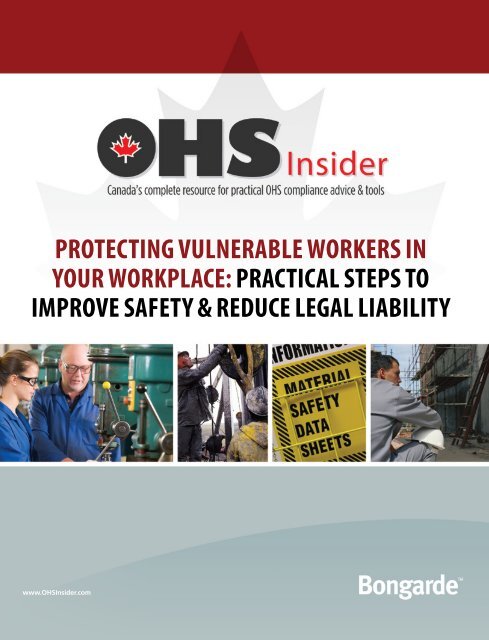
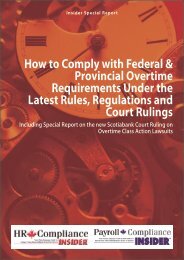
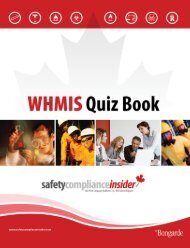
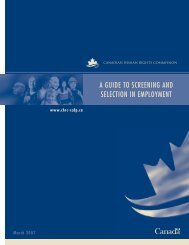
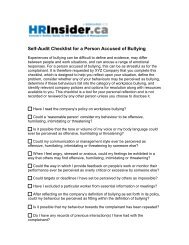

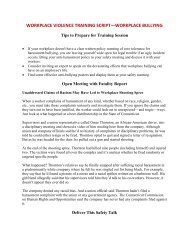


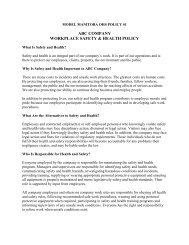
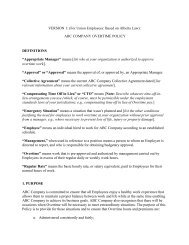
![[company name] workplace violence prevention program - HRInsider](https://img.yumpu.com/35452041/1/190x245/company-name-workplace-violence-prevention-program-hrinsider.jpg?quality=85)

